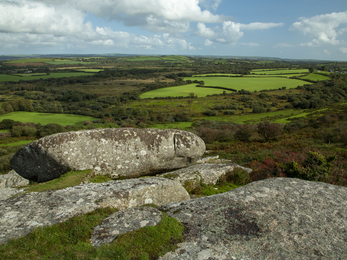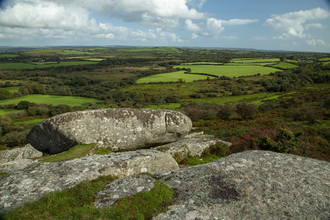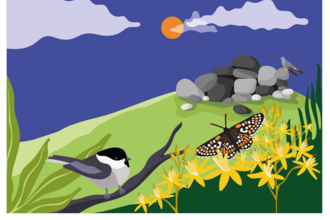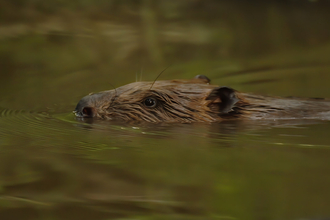Longhorn cattle arrive at Helman Tor. Image by Cornwall Wildlife Trust.
Rewilding Helman Tor Project
We all know that nature is in trouble. Despite Cornwall’s wild beauty, we’re losing precious wildlife here at a shocking rate.
In 2023, we launched an ambitious plan to create the largest ever nature recovery scheme in Cornwall, using pioneering rewilding techniques at our largest nature reserve, Helman Tor.
The Rewilding Helman Tor project will play a major part in getting Cornwall on track to achieve the target, set worldwide, of protecting 30% of land, rivers and seas for nature by 2030.
Thanks to the incredible generosity of our supporters - who raised £62,545 - our Rewilding Helman Tor project is well underway! We now have the required funds to survey, sample and monitor the progress of soils and species, to stock the area quite sparsely with hardy rare breed cattle, ponies, and Cornish black pigs, and to pay for GPS trackers and expertise to check on wildlife movements. We can also add further boardwalks to allow people to watch wildlife without harming the sensitive wetlands, while some fencing may be needed to check the movements of pigs.
From all of us at Cornwall Wildlife Trust, thank you for creating a Cornwall where nature thrives.
Rewilding Helman Tor Appeal Video (C) Cornwall Wildlife Trust
Rewilding can lead to rapid positive results, with species returning and thriving. It could play an important role in Cornwall on sites like Helman Tor, complemented by the hard work of farmers in the wider landscape producing our food in even more regenerative ways.Director of Nature & People, Cornwall Wildlife Trust
Latest updates
Stay up to date
Receive the latest updates and information regarding our Rewilding Helman Tor project, plus hear about exciting events, wildlife news, offers and campaigns and how you can help wildlife in your local area.
What is rewilding?
Rewilding is all about returning natural processes to the landscape so nature can look after itself, leading to dynamic mosaics of different habitats. It may be achieved by allowing rivers to move freely in a floodplain, streams to be dammed by beavers, or introducing large herbivores to roam extensive areas and graze naturally. This reduces the need for humans to manage the land with machinery.
On sites in Cornwall where rewilding principles have been reintroduced – even on a small scale – new ponds created by beavers have attracted dragonflies, amphibians and kingfishers, while dwindling birds such as cuckoos, spotted flycatchers and yellowhammers have reclaimed areas that were previously too heavily grazed or too closely cut for them to stay. Soils turned over by rootling pigs have seen the natural regeneration of grasses, wildflowers and tree seedlings.
Which species will be (and have been) reintroduced?
Through extensive research and careful planning, we will reintroduce species that provide the right conditions for numerous others to flourish. Large herbivores and beavers – the ‘eco-engineers’ of the past, and now of the present and future - will each play a vital role in creating a wilder Cornwall.
Rare breed cattle
In October, with help from funds from the first phase of this appeal, we introduced fifteen longhorn cattle – and we’re looking forward to seeing how they will shape the landscape through habitual grazing, disturbing the ground with their hooves and grazing in a way which encourages an array of beautiful wildflowers.
Pigs
We’ve started trialling pigs on parts Helman Tor, including Creney Farm. It has been fascinating to watch them express their natural behaviour on site: the way they rootle the ground creates germinating opportunities for numerous plants and knocks back the dominant ones which challenge us so much.
Ponies
Beneficial in the rewilding process due to the way they selectively graze on tougher grasses. Ponies love woodlands and grasslands – and the way they graze fosters a range of grasses and wildflowers, increasing biodiversity. Learn more about pony grazing.
Beavers
Wetland's ecosystem engineers. They work around the clock, with their dams reducing peak flows after heavy rainfall and keeping rivers flowing during drought as well as creating a rich patchwork of habitats. Find out more about introducing beavers at Helman Tor or read about the discovery of wild beavers at Helman Tor.
Why Helman Tor nature reserve?
Given the right conditions, landscapes can heal themselves, becoming richer in wildlife and more resilient in the face of climate change. This can be done by responsibly reintroducing key species that have been missing from their habitats in recent times. Filling gaps in the ecosystem can bring about the renewal of a healthy living landscape effectively.
In 2022, an important step was taken with our successful appeal to purchase Creney Farm: a site of 39 hectares (97 acres). The farmland adjoins Helman Tor on three sides. We are hugely grateful for the many donations that enabled that purchase to take place. Through this appeal, Helman Tor has been made bigger; now we want to improve it even further for wildlife through our Rewilding Helman Tor project.
At over 297 hectares (733 acres), Helman Tor nature reserve – a mosaic of hummocky wetland, moorland, grassland and woodland – is ideally suited to host the project.
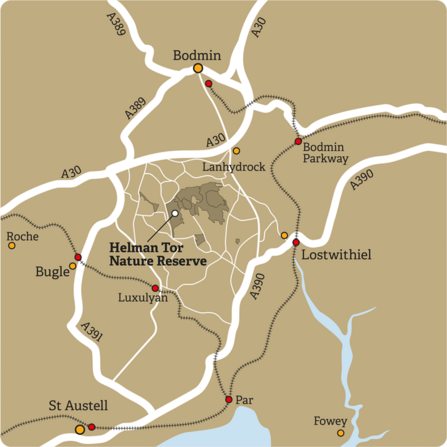
Map showing the location of Helman Tor nature reserve. Lou Jones Design
Get in touch
If you have any questions about the Rewilding Helman Tor project or would like to find out more, please get in touch with us: communications@cornwallwildlifetrust.org.uk
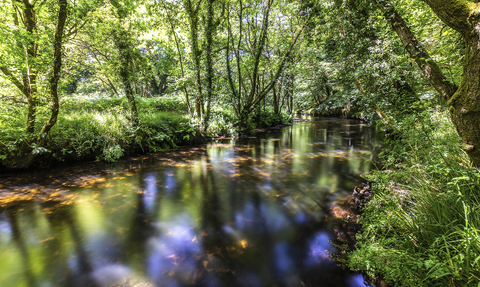
River Fowey from Cornwall Wildlife Trust's Cabilla & Redrice Wood nature reserve. Image by Ben Watkins
Cornwall Nature Reserves Fund

Ben Watkins


